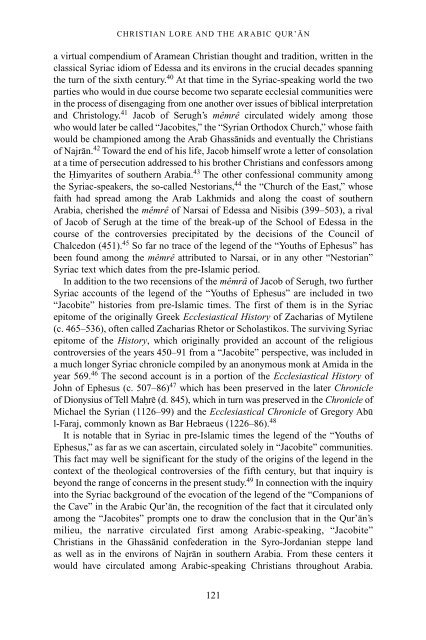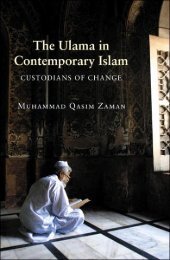The Qur'an in its historical context (pdf - Islam and Christian-Muslim ...
The Qur'an in its historical context (pdf - Islam and Christian-Muslim ...
The Qur'an in its historical context (pdf - Islam and Christian-Muslim ...
You also want an ePaper? Increase the reach of your titles
YUMPU automatically turns print PDFs into web optimized ePapers that Google loves.
CHRISTIAN LORE AND THE ARABIC QUR’AN<br />
a virtual compendium of Aramean <strong>Christian</strong> thought <strong>and</strong> tradition, written <strong>in</strong> the<br />
classical Syriac idiom of Edessa <strong>and</strong> <strong>its</strong> environs <strong>in</strong> the crucial decades spann<strong>in</strong>g<br />
the turn of the sixth century. 40 At that time <strong>in</strong> the Syriac-speak<strong>in</strong>g world the two<br />
parties who would <strong>in</strong> due course become two separate ecclesial communities were<br />
<strong>in</strong> the process of disengag<strong>in</strong>g from one another over issues of biblical <strong>in</strong>terpretation<br />
<strong>and</strong> Christology. 41 Jacob of Serugh’s mêmrê circulated widely among those<br />
who would later be called “Jacobites,” the “Syrian Orthodox Church,” whose faith<br />
would be championed among the Arab Ghassanids <strong>and</strong> eventually the <strong>Christian</strong>s<br />
of Najran. 42 Toward the end of his life, Jacob himself wrote a letter of consolation<br />
at a time of persecution addressed to his brother <strong>Christian</strong>s <strong>and</strong> confessors among<br />
the Himyarites of southern Arabia. 43 <strong>The</strong> other confessional community among<br />
the Syriac-speakers, the so-called Nestorians, 44 the “Church of the East,” whose<br />
faith had spread among the Arab Lakhmids <strong>and</strong> along the coast of southern<br />
Arabia, cherished the mêmrê of Narsai of Edessa <strong>and</strong> Nisibis (399–503), a rival<br />
of Jacob of Serugh at the time of the break-up of the School of Edessa <strong>in</strong> the<br />
course of the controversies precipitated by the decisions of the Council of<br />
Chalcedon (451). 45 So far no trace of the legend of the “Youths of Ephesus” has<br />
been found among the mêmrê attributed to Narsai, or <strong>in</strong> any other “Nestorian”<br />
Syriac text which dates from the pre-<strong>Islam</strong>ic period.<br />
In addition to the two recensions of the mêmrâ of Jacob of Serugh, two further<br />
Syriac accounts of the legend of the “Youths of Ephesus” are <strong>in</strong>cluded <strong>in</strong> two<br />
“Jacobite” histories from pre-<strong>Islam</strong>ic times. <strong>The</strong> first of them is <strong>in</strong> the Syriac<br />
epitome of the orig<strong>in</strong>ally Greek Ecclesiastical History of Zacharias of Mytilene<br />
(c. 465–536), often called Zacharias Rhetor or Scholastikos. <strong>The</strong> surviv<strong>in</strong>g Syriac<br />
epitome of the History, which orig<strong>in</strong>ally provided an account of the religious<br />
controversies of the years 450–91 from a “Jacobite” perspective, was <strong>in</strong>cluded <strong>in</strong><br />
a much longer Syriac chronicle compiled by an anonymous monk at Amida <strong>in</strong> the<br />
year 569. 46 <strong>The</strong> second account is <strong>in</strong> a portion of the Ecclesiastical History of<br />
John of Ephesus (c. 507–86) 47 which has been preserved <strong>in</strong> the later Chronicle<br />
of Dionysius of Tell Mahre (d. 845), which <strong>in</strong> turn was preserved <strong>in</strong> the Chronicle of<br />
Michael the Syrian (1126–99) <strong>and</strong> the Ecclesiastical Chronicle of Gregory Abu<br />
l-Faraj, commonly known as Bar Hebraeus (1226–86). 48<br />
It is notable that <strong>in</strong> Syriac <strong>in</strong> pre-<strong>Islam</strong>ic times the legend of the “Youths of<br />
Ephesus,” as far as we can ascerta<strong>in</strong>, circulated solely <strong>in</strong> “Jacobite” communities.<br />
This fact may well be significant for the study of the orig<strong>in</strong>s of the legend <strong>in</strong> the<br />
<strong>context</strong> of the theological controversies of the fifth century, but that <strong>in</strong>quiry is<br />
beyond the range of concerns <strong>in</strong> the present study. 49 In connection with the <strong>in</strong>quiry<br />
<strong>in</strong>to the Syriac background of the evocation of the legend of the “Companions of<br />
the Cave” <strong>in</strong> the Arabic Qur’an, the recognition of the fact that it circulated only<br />
among the “Jacobites” prompts one to draw the conclusion that <strong>in</strong> the Qur’an’s<br />
milieu, the narrative circulated first among Arabic-speak<strong>in</strong>g, “Jacobite”<br />
<strong>Christian</strong>s <strong>in</strong> the Ghassanid confederation <strong>in</strong> the Syro-Jordanian steppe l<strong>and</strong><br />
as well as <strong>in</strong> the environs of Najran <strong>in</strong> southern Arabia. From these centers it<br />
would have circulated among Arabic-speak<strong>in</strong>g <strong>Christian</strong>s throughout Arabia.<br />
121



